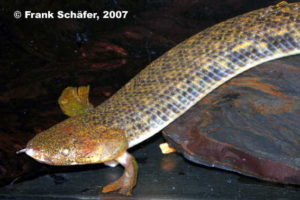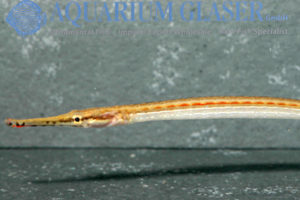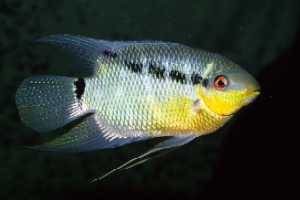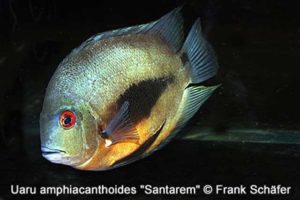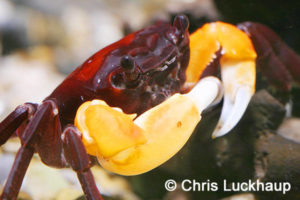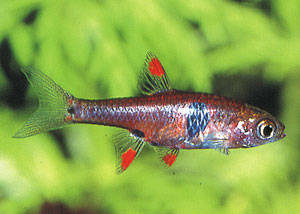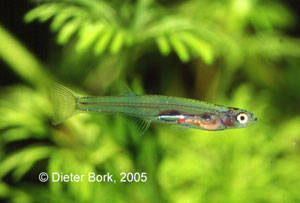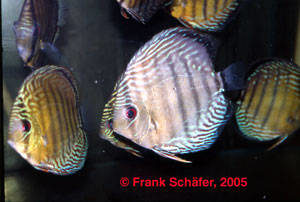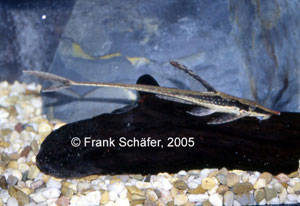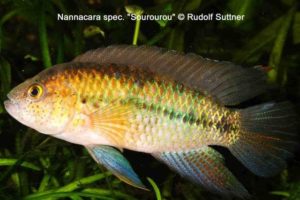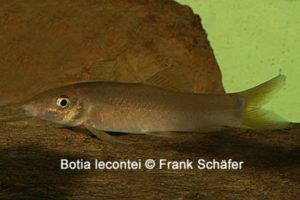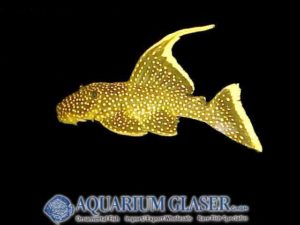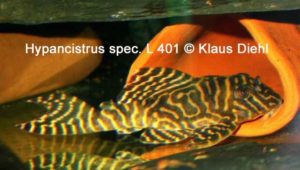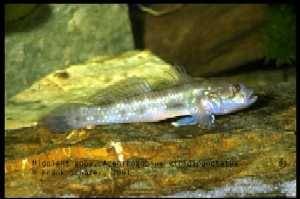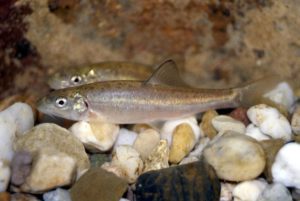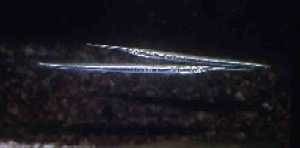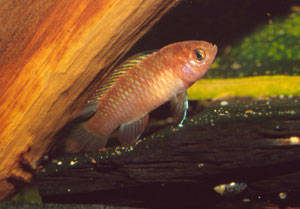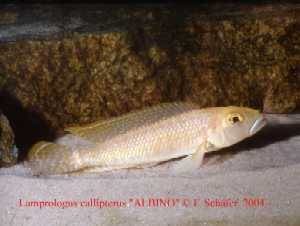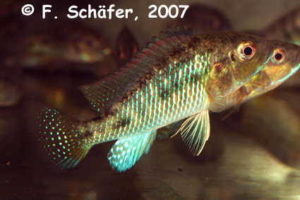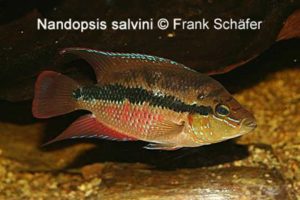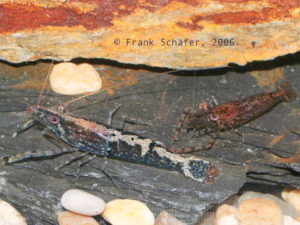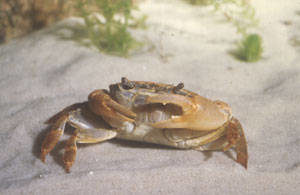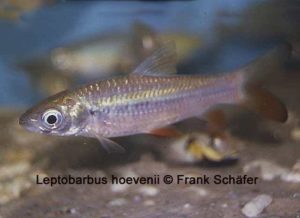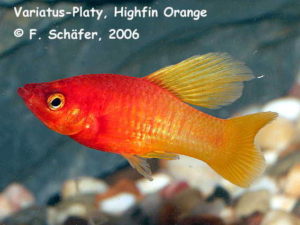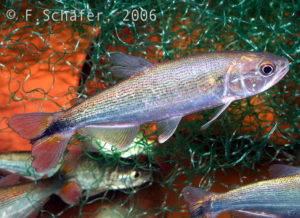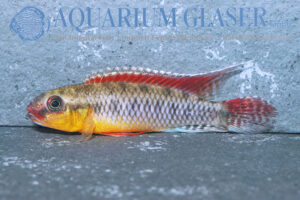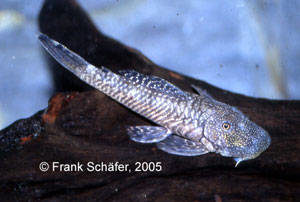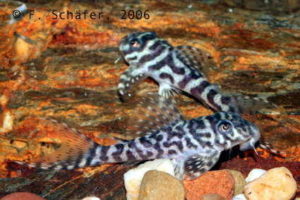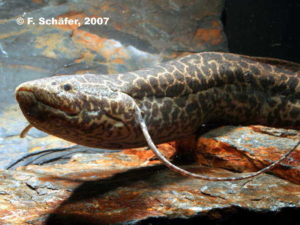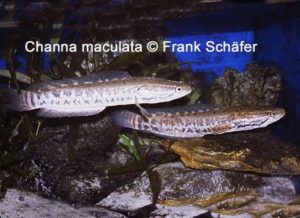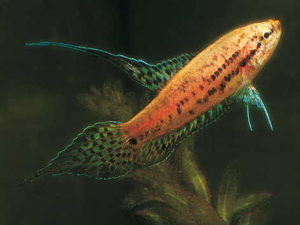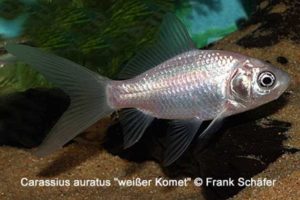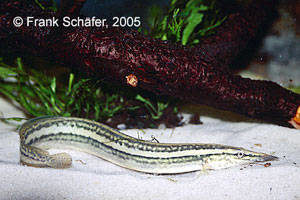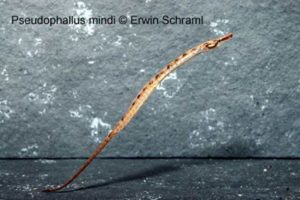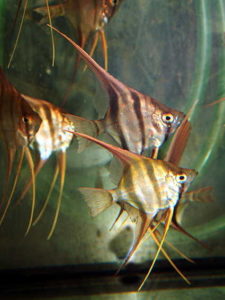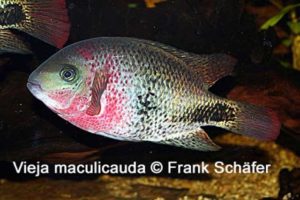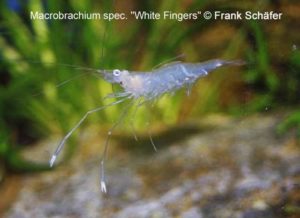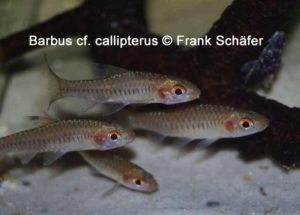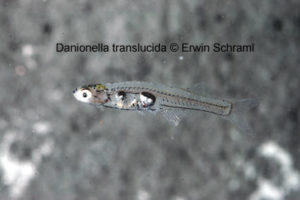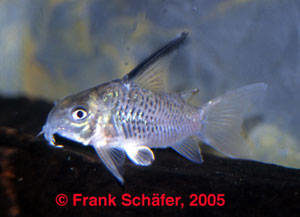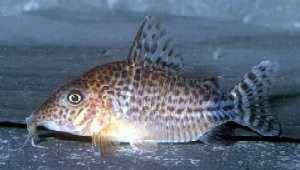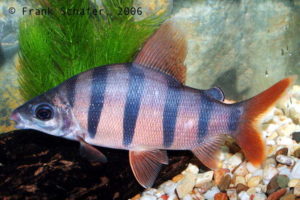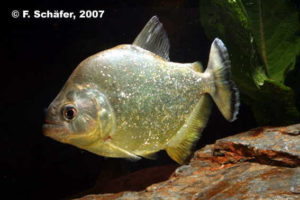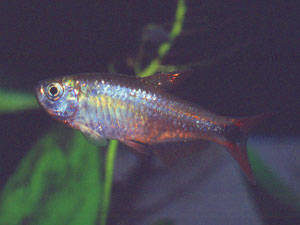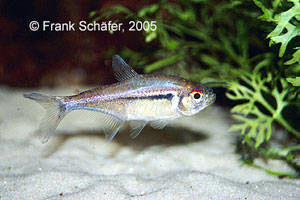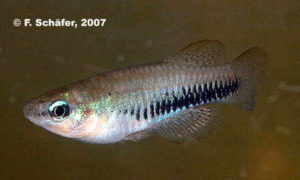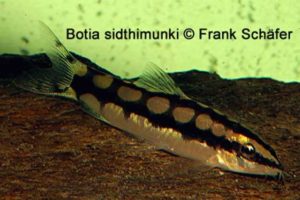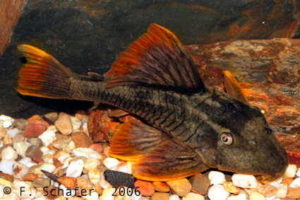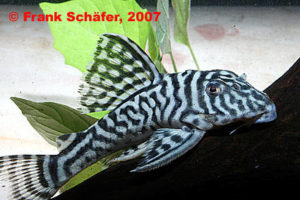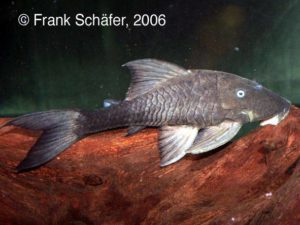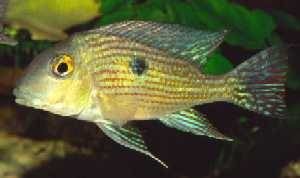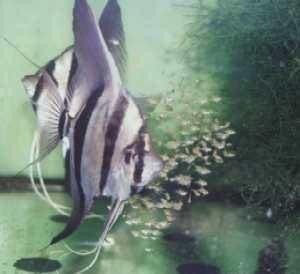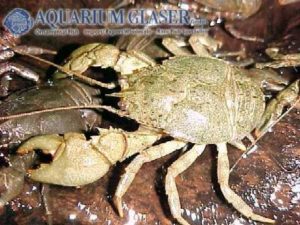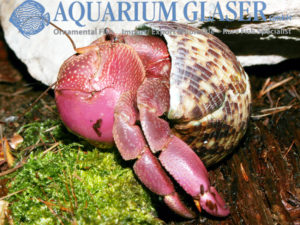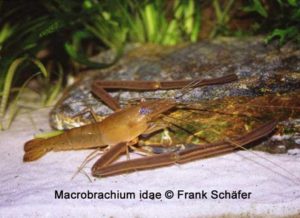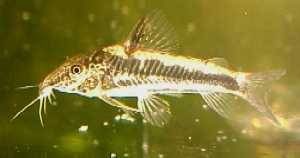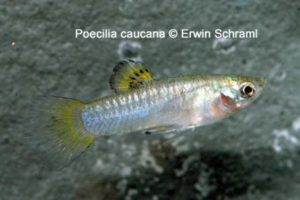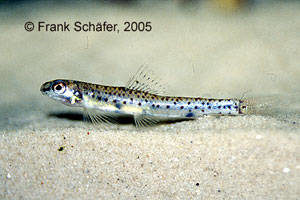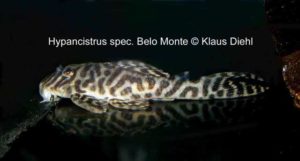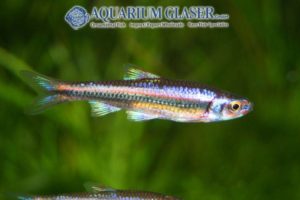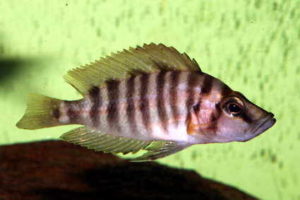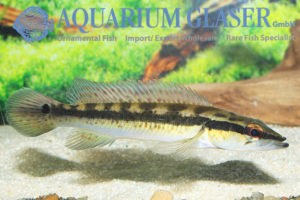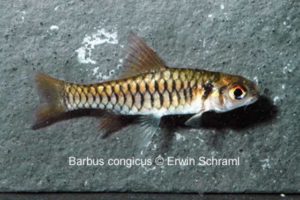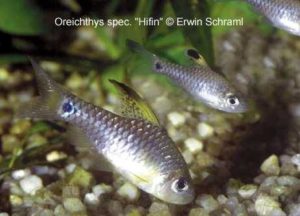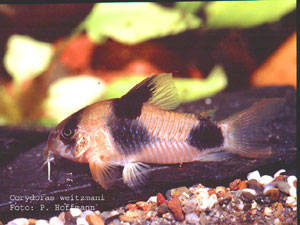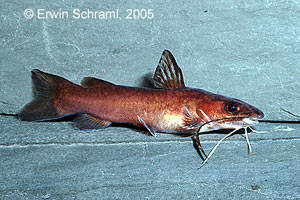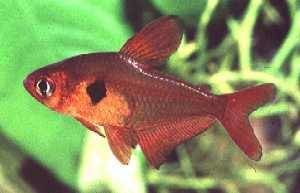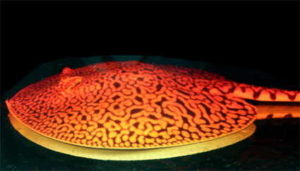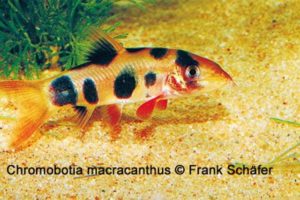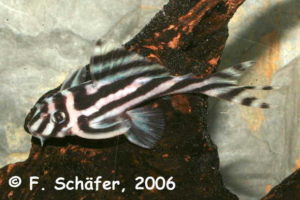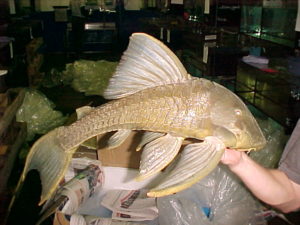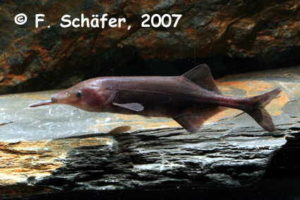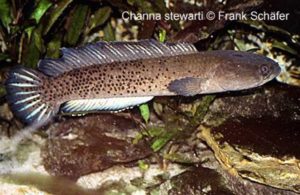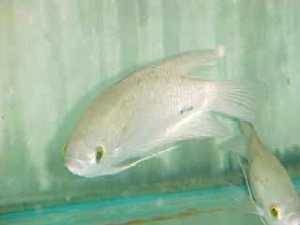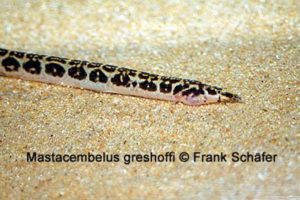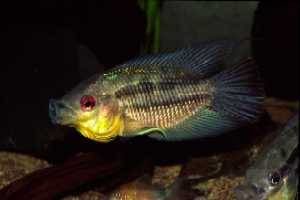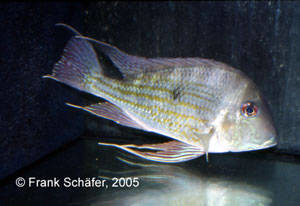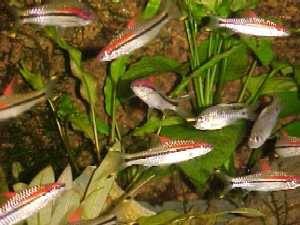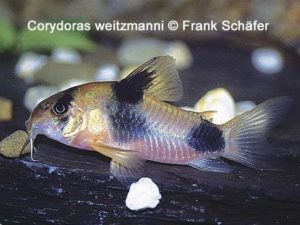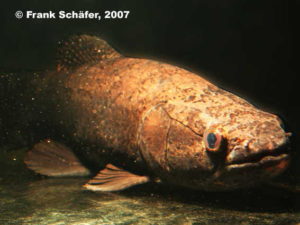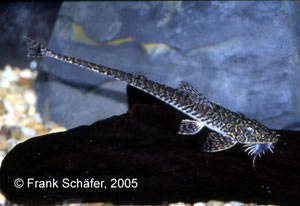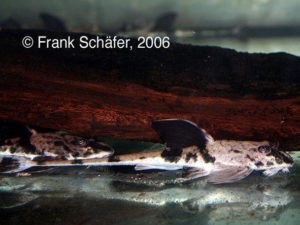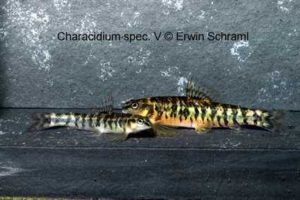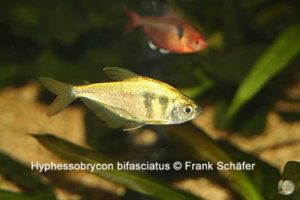One of the most beautiful new fish species of 2003 is this goby, which is rather widely spread in China, Korea and Japan. Already in 1873 Günther described it under the name Eleotris swinhonis of Shanghai, China, but it made its way to our tanks only now. It can reach a maximum size of approx. […]
Fish Archive (3089)
-
-
Polypterus teugelsi
From the Cross River system in Cameroon originates Polypterus teugelsi. This 2004 scientifically described species could be imported in this spring for the first time. They exhibit a black network, which covers an olive background on the dorsal and dorsolateral surface of the body. This and their brightly orange colored belly are singular in bichirs. […]
-
Microphis lineatus
The species Microphis lineatus inhabits the (sub) tropical coastal waters of the American continent. This pelagic pipefish grows up to 22 cm lengths and has a very long slender snout with red spots and blotches. The body is brown or greenish above and pale below. There are very small white spots on the body and […]
-
Mesonauta insignis
This cichlid, which is growing up to approx. 20cm is living along the catchment area of the Orinoco, whereit mostly lives in slowly flowing or even standing waters. You often find it right in front of the shore, where it inhabits the upper water layer. Regarding the nutrition M. insignis is totally uncomplicated, because these […]
-
Uaru amphiacanthoides -Santarem-
At present we can offer this magnificent variant of Uaru amphiacanthoides originating from Santarem. The fish impress by their metallical resplendent body and the cherry red eyes. All Uarus are expressed plant lovers. Beside a meaty nutrition vegetarian food should be offered. The food spectrum is large, almost all fruit and vegetables are accepted and […]
-
New Crab
June 2006: Is considered already nearly as rule: Every week we get an new crab. Under the trade name “goldenpincer crab” we could firstly import few exemplars of a new, still undescribed crab species from Southeast Asia. Further iInformation will follow. (Photo C.Luckhaup, Text K.Diehl)
-
Boraras cf. micros
THE SPECIES HAS BEEN DESCRIBED SCIENTIFICALLY IN THE MEANTIME UNDER THE NAME OF BORARAS NAEVUS. PLEASE CHECK THE FOLLOWING PAGE: http://www.aquariumglaser.de/en/boraras-naevus_de_1397.html This scientifically undescribed dwarf fish was imported from Singapore. They have very bright coloration and will not outgrow 1.5 cm in length. Like all Boraras dwarfs these fish need a special aquarium on their […]
-
Danionella aff. Mirifica
This species is the smallest representative of the carp family. It length does not exceed 1.5 cm. This fish comes from Myanmar (former Burma) and is imported only rarely. It is a typical shoaling fish and apparently lives in nature in large formations. Male fish attract the females for mating with clear croaking noises. These […]
-
Labiobarbus leptocheila
Labiobarbus leptocheila is a up to 30 cm long barb originating from Southeast Asia. There it is found from the Mekong area over the Malayan peninsula to Java, Sumatra and Borneo. Typically for the genus Labiobarbus is the protracted dorsal fin, as well as through black marks on the scales formed longitudinal stripes. In their […]
-
Diskus „Wild Lago Inanum“
This very beautiful discus fish is traded as well under the name „Semi Royal Blue“. Wild caught discus fish are just beautiful! It is remarkable that still new wild type varieties are found and imported. Wild caught discus fish will not be feeling themselves well if not kept under optimal conditions. This malcontent will be […]
-
Sturisoma sp. „Colombia“
This for science unknown species was imported with a unique shipment from Colombia. Sturisoma sp. „Colombia“ was found in the Rio Chaco in the North of Colombia. This elegant Sturisoma species differs from the short finned species, which live on sandy habitats as well as from Sturisoma festivum by difference in colouration and body form. […]
-
Nannacara spec. -Sourourou-
From the Crique Sourourou in French Guyana originates this beautiful new Nannacara variant. We are pleased to be able to offer some offspring to you. According to information of an experienced Nannacara specialist their maintenance is unproblematic, even in middle hard water. The breed however succeeds only in soft and sour water according to their […]
-
Terranatos dolichopterus
May 2002: New arrival: german bred Terranatos dolichopterus, sailfin-killi (Aqualog “New World Killis, page 190 log-no: S27715). This fish comes from Venezuela, grows up to 5cm and should be kept in groups. The bottom of the tank should be peat, because they “dive” into the bottom when they spawn. (Photo F. Schäfer, Text K. Diehl)
-
Yasuhikotakia lecontei
From the watershed of the Mekong originates this circa 15 cm long getting loach. The name red finned loach is something misleading, since not all animals show this colouring in all stages of age. During their development they change colours and pattern. Young animals usually exhibit a pattern of stripes which disappears during ageing. In […]
-
Baryancistrus sp. L-81 HIGHFIN
September 2003: This week we received from Brasil a really unique fish: L-81 HIGHFIN. Our supplier advised us to send this fish and it really was worth waiting….was it not?(Photo F. Schäfer, Text K. Diehl)
-
Hypancistrus spec. L 401
This in the DATZ 12/05 introduced very beautiful Hypancistrus variant is at present in a small number available. The animals remind in their habitus of L 333 and with these are also occasionally confounded. In the figure they are more delicate, somewhat more stretched and reach only one overall length of maximally 12 cm, while […]
-
Acentrogobius viridipunctatus
This magnificent goby, it´s scientific name is Acentrogobius viridipunctatus, has now been successfully imported from India for the first time in greater numbers. The species attains a length of maximum 15 cm. Fully grown males have a very thick skull. In breeding mood, the fish become complete black in base colour, on which the emerald […]
-
Barbus barbus
This endemic species can be found through Europe, from France to the Memel River, in England in the Thames and a few other rivers and in the Danube and its tributaries. During the breeding season the male fish have a cloudy secrete on the head with white nodules. The females are considerable bigger and rounder […]
-
Potamorrhaphis guianensis
These fish belonging to needlefish (Belonidae) reach the aquariums of interested hobbyists only very seldom. These robbers, called halfbeak, come from almost all over Amazonia. You can find them also in the Orinoco catchment area as well as in the Guyana countries. These specialized surface fish are only suitable for the the hobbyists with restrictions […]
-
Dario hysginon
Compared with Dario dario this species is hardly known by the general aquarists, although the males who obtain and guard their territory are looking very beautiful. Although they do not display the coloration like D. dario, they definitely show the same intense red colour. Unfortenately D. hysginon only shows his full colour when he is […]
-
Lamprologus callipterus ALBINO
August 2004: Now available: Lamprologus callipterus ALBINO. After several years, one of our breeder was successful in breeding this species. We have this fish for the first time in stock. You will find here more details soon.(Photo F. Schäfer, Text K. Diehl)
-
Pseudocrenilabrus philander
May 2007: From the Congo we received Pseudocrenilabrus philander. The fish originate from the upper parts of the Congo river (Lualaba). Their area of circulation covers nearly the entire southern Africa, where they are to be found in practically all types of waters. As mouthbreeders in the female gender their courtship and broodcare run after […]
-
Nandopsis salvini
December 2006: At present we can offer a very beautiful, strongly red coloured variant of Nandopsis (Cichlasoma) salvini to you. They origin from South Mexico, Belize and Guatemala, where they live in to the Atlantic ocean heading streams. Like most Central American cichlids they are very easy to keep in middle hard water at pH […]
-
Macrobrachium brasiliensis
July 2006: From the Amazon area we could import an rarely imported Macrobrachium species. Macrobrachium brasiliensis has a large area of origin from French Guyana to Peru in the basins of the Amazon and Orinoco. There they inhabit predominantly small creeks full of leaf litter. They feed mainly on detritus and are an important member […]
-
Oziothelphusa ceylonensis
An amazing variety of crustaceans can be found in tropical fresh- and brackish water areas. Only few species however are imported regularly. Recently this species was imported which comes from Sri Lanka, as one could guess from its name. O.ceylonensis is a pure freshwater species, with a carapax width of 6 cm and a colour […]
-
Leptobarbus hoevenii
Leptobarbus hoevenii the Cigar Shark or Mad Barb is a giant within the barbs. With a length of approx. 1 m and a weight of up to 10 kg the Cigar Shark already places a very special requirement: It needs a lot of space. For the maintenance of adults one should own a tank of […]
-
Platy variatus „Highfin Orange“
This Highfin Platy certainly belongs to the most beautiful new breds of the last time. The flowing transition from scarlet to yellow and its enlarged backfin makes it’s attraction. Since it doesn’t differ from other Platys in it’s keeping demands, it will certainly become a gain in der Aquaristik.
-
Salminus brasiliensis (formerly: maxillosus)
April 2004: At present Aquarium Glaser can offer Salminus brasiliensis (formerly: S. maxillosus) as a further characin rarity. This up to 1 m and over 20 kg growing fish is a migratory species. These migrations take place from October to January, and are correlated with the rise of the water levels as well as the […]
-
Nanochromis sp. „Lezas“
With Nanochromis sp. “Lezas” we can offer a further highlight of German bred fishes. As at the before introduced species this dwarf cichlid is hardly to be exceeded in colour and quality. Particularly noticeable is the strong red colouring of the dorsal – and the upper parts of the caudal fin. In dark, peat-coloured water […]
-
Chaetostoma pearsei L 187
This Chaetostoma species is imported in regular intervals from the upper Orinoco through Puerto Ayacucho. This catfish is very difficult to differentiate from L 147 and L 188. L 188 has often described in the literature as C. nudirostre. C. pearsi lives in fast streaming mountain brooks and therefore needs in the aquarium oxygen rich […]
-
Hypancistrus spec. L 66 „King Tiger“
As one of the early imported representatives of the so-called L-number catfishes L 66 has already an unbroken popularity. At present we can offer beside wild caughts also very beautiful german breds. Such bright grounded L 66 are at least as attractive as the most „newer“ Hypancistrus species. With a final size of approx. 15 […]
-
Protopterus aethiopicus congicus
Freshly arrived: Marbled lungfishes (Protopterus aethiopicus) rank among the genuine survival artists. For respiration they are dependent on atmospheric air, if one refuses them the admission to the surface, they can drown in the water (aquarium). The air breathing allows them, however, a nearly amphibious way of life. So they are able to withstand desiccation […]
-
Channa maculata
Channa maculata is a snakehead which origins of the border area of China and Viet Nam. It is there very common and offered on markets in large numbers, naturally as a food fish. In their habitat C. maculata lives in ponds, lakes and ditches, usually over sandy or muddy bottoms. With a final size of […]
-
Malpulutta kretseri
September 2006: As German breds we can offer Malpulutta kretseri. These preciousnesses are very rare in the wild and therefore strictly protected in their homeland (Sri Lanka). There they inhabit soft and sour waters and therefore their keeping in aquaria can be somewhat difficult. Small, dimly lit species tanks with a lot of shelters are […]
-
Carassius auratus „Weißer Komet“
At the first warm days of march humans get a certain urge to go outdoors. In the garden is exactly looked how everything becomes green and also the pond gets a first critical inspection and stocktaking. Who wants to supplement the fish population, can plan now and should include the white comet to its considerations. […]
-
Macrognathus aral
This spiny eel originates from South East Asia, i.e. Pakistan, India, Sri Lanka, Bangladesh, Nepal up to Myanmar in their most southern distribution area. This fish is dawn and night active and will eat small fish. Therefore it should only be kept with larger tank fellows. In their natural habitat this species can reach a […]
-
Pseudophallus mindii
Pseudophallus mindii is a short snouted pipefish, which reached us as a by-catch in two exemplars. Their distribution contains central and tropical South America, where it is found predominantly in freshwater habitats. Adults were caught from estuaries and mangrove areas too, while planktonic juveniles have been collected well offshore at sea. As other pipefishes and […]
-
Pterophyllum altum
The new season began, Pterophyllum altum (Orinoco) is available again. Deep Angels can reach 20cm length and up to 35cm in height. This has to be considered with the tank purchase, it should have a height of at least 70cm. A decoration with large bogwood, provides structure and retreat possibilities for them. Since they are […]
-
Vieja maculicauda
Vieja (Cichlasoma) maculicauda the Blackbelt Cichlid is one of the larger Central American cichlids. Males can reach about 35 cm overall length. According to its size one needs voluminous aquaria, where their interesting social behaviour can be observed. In their distribution area (Atlantic slope, from the Usumacinta River drainage in Guatemala to the Chagres River […]
-
Palaemon concinnus
Over an enormous range, that includes nearly the entire Indo Pacific those first as Macrobrachium “White Fingers” designated Palaemon concinnus can be found. Their bright white “shear-fingers” are very remarkable and give this from Sri Lanka imported species a special attraction. It is about a rather delicate, smaller species, thus one could try to socialise […]
-
Barbus cf. callipterus
This strongly at Barbus callipterus reminding barb reached us from the tropical west Africa. Whether it is a variant of the Clipper barb B. callipterus or a near related species could yet not be clarified. The further information refers to the general maintenance conditions of bigger barb species.They are social swarm fish, which should be […]
-
Danionella translucida
Danionella translucida would have earned an entry in the Guiness book of world records. The largest measured individual was only 12mm long, thus acts it with this species around the smallest vertebrate anima. Apart from their extreme smallness the absence of sheds, as well as the high transparency of the dwarves are noticeable. They origin […]
-
Corydoras armatus „spotted“
April 2005: These beautiful animals where imported from Columbia. The literature however give Peru and Brazil as their place of origin. For more then 125 years ago these fish were described by Günther and since then hardly ever imported. The characteristic features of this catfish is the extreme long dorsal fin of which the first […]
-
Corydoras spectabilis
In fact we have ordered Corydoras guapore from Manaus,…but what we got was totally different. We got for the first time Corydoras spectabilis, which is found in the upper Rio Guaporé around Vila Bela. (Photo E. Schraml, Text Aquarium Glaser)
-
Distichodus sexfasciatus
From the Congo River basin in the Democratic Republic of the Congo (formerly Zaire) originates Distichodus sexfasciatus. This in the aquarium to approximately 30 cm growing characin is a pronounced herbivore. This has to be regarded for the basin setup, since most smooth leaved plants are regarded as food. Some hardy plants as Anubias- or […]
-
Serrasalmus cf. brandtii
From the Rio Sao Francisco originates this with Serrasalmus brandtii closely related species. They are quite aggressive and as young fish they can be held as a shoal in the species aquarium. Adults with a size of over 30cm length need then naturally very large tanks. At first freshly imported Piranhas accept usually only living […]
-
Hasemania sp. „Red“
This small characin is a very attractive fish and a fast swimmer as well. It could be determined as a representative of the Hasemania genus, because it misses the characteristic adipose fin, which is one of the features that determine characins. Up to now we used to have only one species belonging to this genus, […]
-
Hyphessobrycon agulha
This very attractive Tetra originates from the Rio Madeira, which runs into the Amazon River downstream from Manaus in Brazil. This Characin species will probably not grow much larger then 6 cm. They are friendly and lively schooling fish, very suitable for a community tank. These fish are not difficult in keeping and will tolerate […]
-
Aplocheilichthys katangae
From the Katanga province of the Congo we recieved Aplocheilichtys katangae. These non seasonal killies have a large distribution area in the central southern Africa. There they inhabit shallow, overgrown brooks and ponds. Their maximum size is approximately 6 cm. They feed on small water insects and crustaceans in tanks they can be fed with […]
-
Yasuhikotakia sidthimunki
From northern Thailand originates the Dwarf Loach formerly known as Botia sidthimunki. Since it is a rather small (6 cm) and very peaceful species, it represents an ideal member for an asiatic community tank. There it can be kept together e.g. with small representatives of the genera Danio, Rasbora and Microrasbora . One should always […]
-
Cochliodon sp. YELLOW SEAM L 360
From the Rio Jamanxim in Brazil we could import a small number of L 360 with nice yellow-orange fins. They are unproblematic in the maintenance need however a high portion of vegetables in their food. Similar as Panaques this over 30 cm large growing species specieseats large quantities ofr bogwood. A high performance filtering unit […]
-
Hypancistrus spec. NEW
September 2006: Latterly we received this very rich contrasted male of an unknown Hypancistrus species. Certainly here exists a similarity to L 333 and also Hypancistrus spec. Xingu. It gets more and more difficult to attach single fishes to existing L numbers or to a known Hypancistrus species, because there are not enough hard criteria […]
-
Panaque cochliodon
December 2005: After years when no Panaque cochliodon (Panaque suttoni, P. suttonorum) were imported, now again few individuals reach us. Whether environmental problems or the civil war in parts of Colombia are responsible for their non appearence, can not be judged from a distance. We are glad to see this in former times not rare […]
-
Geophagus sp. „Pindare“
Among the “Eartheaters”, species Geophagus, G. sp. “Pindare” is one of the most recommendable ones. Growing up to approx. 15cm only, it stays rather small and also shows a beautiful marking with red and blue lines on its flanks. The care of this species is really quite simple, because it does not care about the […]
-
Pterophyllum altum german bred
November 2003: Lately we received German bred Pterophllyum altum. It is worth mentioning that this was a natural brood, eg both parent took care for eggs and the young. Even spawning of the Altum Angel is a remarkeble event. This species tends to get panic attacks when the fish is fully grown. Thus they tend […]
-
Aegla platensis
There are more than 60 species, all of them exclusively inhabitants of freshwater, in the genus Aegla, which belongs to the family Aeglidae. All Aegla species are inhabitants of southern South America. To date they have hardly ever been seen in the aquarium hobby. The specimens recently imported by Aquarium Glaser demonstrate, however, that Aegla […]
-
Coenobita brevimanus
The hermit crab C. brevimanus origins from coasts of the Indopacific, where it is found from the east coast of Africa to Tahiti. Coenobita brevimanus is the most terrestrial of all land hermit crabs. For the maintenance one needs a terrarium with only shallow water, because they do not like to get wet. Since they […]
-
Macrobrachium idae
January 2006: The long arm shrimp Macrobrachium idae reached us from Sri Lanka. Remarkable are their extreme long, name-giving “arms”, which can give the full grown animals an enormous broad reach. With that they are able to track small fish successfully, which naturally limits their use in the community tank. Together with larger fish species […]
-
Corydoras baianinha
March 2003: Some weeks ago we received a few pieces of Corydoras baianinha. This extreme rare Corydoras only occurs in a little number of small streams in the south of Brasil. The population of Cordoras baianinha is very much in danger, because its living space was already largely distroyed by environmental pollution and forest clearing! […]
-
Poecilia caucana
With an overall length of 3 – 5 cm the Cauca Molly (Poecilia caucana), originating from Colombia and Venezuela, belongs to the smaller living-bearers. Remarkably is the yellow – orange coloured dorsal fin and a violet metallically shining longitudinal line. The water equivalents (pH values of 8,2- 8.6, LF 360 and 420 Mikrosiemens/cm), based on […]
-
Hemibrycon spec. „Paraguay“
In the last years some quite difficult to classify new species of characins arrived from Paraguay. Usually they belong to the genera Creagrutus, Hemibrycon and Piabarchus. As a common characteristic a high swimming activity can be called for all species of this relationship. They need thus tanks, with a large free swimming area. Thus long […]
-
Ammocryptocharax sp. „spotted“
This scientifically undescribed ground tetra originates from Peru. This is a peaceful species also when housed with delicate fish. This is a medium size tetra fish, which probably does not grow larger then 5 cm. If more then one male of this ground tetra inhabits the tank then they can become somewhat territorial and therefore […]
-
Botia sp. „New Emperor“
The ever first import of Botia sp. “New Emperor”, probably comes from the borderland of Burma/Thailand. It should appear in a decadal yearly rhythm in a large amount and can only be caught then. An area informed ichthyologist stated that transportation through bordering hilly regions can only be helped by small mopeds, where a slight […]
-
Hypancistrus spec. „Belo Monte“ (L 287, L 399, L 400)
The denomination of this beautiful Hypancistrus is still disputed. It run long time under the number L 287, so it is named on our stock list. Recently it is called L 399 and/or L 400, the origin is the Rio Xingu, where it gets caught in the neighbourhood of Belo Monte. This species belongs into […]
-
Notropis chrosomus
(21.Jan.2008) Rainbow Shiner, that is what they are called! We have this dream in limited numbers available. They are really easy to keep and grows up to 6cm. They do not demand special water conditions, but they should be kept in water which is rich of oxygen. Their origin is Northamerica. You can find them […]
-
Altolamprologus compressiceps
From the shores of lake Tanganjika orgins (Alto)lamprologus compressiceps. There the about 13 cm long getting fishhunter inhabits the detrital zone, which it roams on search for food. When a prey is seen it approaches in slow motion, near the booty it speeds up and catches the victim. Because of its strong lateral flattening it […]
-
Crenicichla spec. ITAPEMIRIM
We received this extremely colorful species of Crenicichla from the southeastern part of Brazil. In adults the sexes can be distinguished quite easily. Females (see main photo) have an ocellus in the dorsal fin which is missing in males (see additional photo). Moreover, in males the deep red spots are scattered over the body, whereas […]
-
Barbus congicus
The Congo Barb is a rarely traded ornamental fish. As you can see by their name Barbus congicus originates from the Congo river in Central Africa. With a length of 7 – 8 cm it belongs to the medium sized barbs and should, according to its vivaciousness, not be maintained in to small aquariums. With […]
-
Oreichthys crenuchoides (=spec. Hifin)
This barb out of the relationship of Oreichthys cosuatis measures about 5 cm. They originate from northern India. This species is characterised by a pronounced sexual-dimorphism, the males are more larger than females, only them show the magnificent, flag-like increased dorsal fin. The fish tank should be decorated with dense patches of plants on the […]
-
Corydoras weitzmani
This is one of the most spectacular representative of the Corydoras genus recently imported. For us this is the ultimate Corydoras. Its closest relative is probably Corydoras panda. The body pattern is similar to the recently described Corydoras tukano. This species was caught by the authors in September 2004 in the riverine system of the […]
-
Phyllonemus typus
The Spatula-barbeled Catfish, endemic for Lake Tanganyika, has a very special way of reproduction for catfish: they are biparental mouthbreeder. This small catfish is the only representative of its genus and can be easily distinguished by the long barbels on both sides of the upper jaw, which are ending into a spatula form. The total […]
-
Red Phantom tetra, Hyphessobrycon sweglesi
Until a few years ago Red Phantom tetra, Hyphessobrycon sweglesi was easy to identify, even though under the name of Megalamphodus sweglesi. Lately “Red Phantom Tetras” appear more often, which are very similar to it, but also show other characteristics. It stays (temporarily) unclear, if they are own species, subspecies or “local forms”. Interested hobbyists, […]
-
Potamotrygon menchacai
September 2006: From Potamotrygon menchacai, the tiger stingray, we could import a big, very beautifully patterned, female animal with approximately 60 cm in diameter. Tiger-rays can be colored quite differently and particularly can differ in the contrast. Our tiger rays come from Peru, through size and scrutiny, they certainly are among the most impressive “ornamental-fishes.” […]
-
Chromobotia macracanthus
In our picture you see an interesting mutant of the clown loach, which reached us these days. Although Chromobotia macracanthus formerly known as Botia macracantha is a long time tank inhabitant, it is still not without mysteries. This applies particularly to the breed, so far we have only coincidence success. Also in the maintenance they […]
-
Hypancistrus zebra L 46 „Double Tailfin
November 2006: At present we can offer beside „normal “German bred zebras (surely the most demanded of all L-numbers) an individual with a doubled lower caudal fin. This change of the fin is probably to be led back on a disturbance in the embryonic development. If someone hopes to breed a race of „veil tailed […]
-
Panaque spec.
June 2006: Just freshly arrived! Also for „old stagers“ there are again and again genuine surprises with us. In a shipment from Peru we received today several particularly delicate Loricariids, which represent a petite alternative to the frequently maintained Hypancistrus species. However their size of (50 – 70 cm) probably exceeds the possibilities of most […]
-
Gnathonemus longibarbis
March 2007: From the environment of Lubumbashi, the second largest city the Congo comes Gnathonemus longibarbis to us. They were caught in close proximity to Bondaka and are probably for the first time in the trade. In nature they feed on water insects and their larvae, their final size probably lies at approx. 40cm. Since […]
-
Channa stewartii
This often under the name Channa cf. barca traded Snakehead originates from the Indian province Assam. C stewartii can reach a length of 30 cm and as predators they should kept together only with fishes whose length exhibits at least 2/3 of their body length. Beside living and dead fish they accept food as insects, […]
-
Osphromenus exodon
Even this fish looks like the common gourami, it is really something special & rare. As far as we know, this species was never before importet to Germany. When they have the size of about 30-40cm, they turn their lips inside out and show many small white teeths. Unfortunately this stadium is only shown in […]
-
Mastacembelus greshoffi
Some time ago we could import Mastacembelus greshoffi from the Congo. Here we have a spiny eel getting approximately 35 cm long, which occurs over rocky bottoms in rivers and lakes, also in rapids. Spiny eels are intelligent fish, they show a multiplicity of interesting behaviours. They also can become amazing tame and eat then […]
-
Chaetobranchopsis orbicularis
Chaetobranchopsis orbicularis is a plankton eater, which can reach a total length of up to 20cm. This may be one of the reasons, why it is not getting imported too often, as such nutrition specialists are mostly only interesting for specialists and enthusiasts. Yet the care of this species from Brasil is not neccessarily difficult, […]
-
Geophagus sp. „Tananaco“
This very beautiful representative of the surinamensis complex comes from Venezuela. These are very large animals of approximately 25 cm TL. The requirements of keeping, this species is not much different then the other members of its family. A sandy substrate, lots of shady hiding places like bogwood and round eroded stones, are basic requirements, […]
-
Barbus denisonii
This splendid fish is endemicly (i.e. only there and nowhere else) found in several coastal rivers of South India. That is why only small quantities may be caught and exported as aquarium fish. You keep this fish best, which is used to flowing waters, in biggest tanks possible in a shoal. The feeding with frozen […]
-
Corydoras weitzmani
February 2006: We are pleased to be able to offer you the first offspring of a legend. Now offspring of the recently again discovered and in the last year for the first time to Germany imported Corydoras weitzmani are available. Fortunately this beautiful small, at Corydoras panda reminding species, could quite fast be spawned by […]
-
Hoplias macrophthalmus
With Hoplias macrophthalmus we could import from Colombia one of the biggest predatory fishes of the Amazon river system. Contrary to the regular imported Hoplias malabaricus these arrive only extreme rarely in the trade. As an adult with a weight of over 40 kg and a length of more than 120cm they belong to the […]
-
Crossoloricaria cf cephalaspis
The 5 species of the genus Crossoloricaria are all looking very similar to the flounder Loricariid genus Pseudohemiodon. These fish have as well a flattened body form, small eyes lying distally on the triangularly formed head. The difference between these two genii is the missing of the ventral bony plates of Crossoloricaria. Only at the […]
-
Loricaria simillima
Loricaria simillima has a very wide distribution in South America. It is found in the Orinoco-, Amazon- and La Plata basins. A result of this large area many different color forms are known, which differ clearly regarding coloration and pattern. The species occurs in different water types. Black water forms are more demanding in maintenance […]
-
Characidium spec. V
This prettily drawn representative of the genus Characidium reached us over Rio de Janeiro, its actual occurrence area is unknown. A classification of the more than 50 Characidium species is difficult, for orientation we here adopt the numbering of the Aqualog photo collection. As natural biotope small clear watercourses are to be assumed. The water […]
-
Hyphessobrycon bifasciatus
The Yellow Tetra originates like its close related Von Rio Tetra from coastal rivers in southeast Brazil. With its pretty yellow basic colour it forms a beautiful contrast to it and other reddish characin species. As a schooling fish the Yellow Tetra should be kept only in larger swarms. Particularly in not too brightly lit […]





